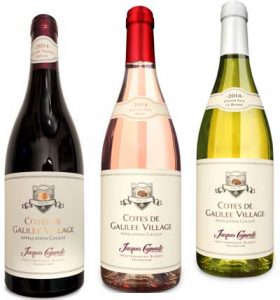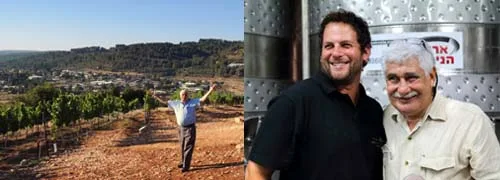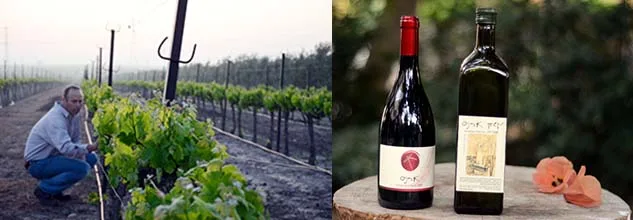In 2004 restaurateur Jacques Capsouto started on a journey that brought him to Israel, to plant vines and create one of Israel’s newest wineries.
He came to for a wedding and took time to visit a few Israeli wineries. He talked to winemakers, walked the vineyards and tasted the wines. He was surprised at the quality and put a number of Israeli wines on the wine list of his Tribeca restaurant in Manhattan. He said he did it for business reasons only, “because they were good.“
Then it was extremely rare for a non-kosher restaurant to select a number of wines from Israel and it took someone of the conviction of Jacques Capsouto to make the effort and back it up. He challenged his customers to try the wines, telling them “If you do not like the wines, you don’t need to pay for them.”
He explained “Israeli wine does not have the attack of fruitiness that the new world has but doesn’t have the subtlety that the European wine has. You have a nice middle ground between the two.”
In 2006 he was invited back as a guest to IsraWinExpo and a new dream came into mind. His mother Eva had always said to him “do something for Israel.” So he decided not only to become an ambassador for Israeli wines but to make his own.
Capsouto was born in Egypt to parents who came from Turkey. He moved to France with his family aged and lived in Lyon for four years and then the family moved again to the United States, where he made his home.
In Manhattan he founded the Capsouto Freres Restaurant with his brothers, which he ran for over thirty years. The restaurant helped put Tribeca on the map. For thirty years they maintained the exacting standards in the most competitive restaurant city in the world. It is difficult enough to find a quality restaurant in Israel that has lasted 10 years!
Then came two hammer blows. Firstly his brother Albert, a constant and crucial partner in the business tragically passed away well before his time. Then came Hurricane Sandy. A life’s work was destroyed in a single storm. The restaurant was flooded, fixtures destroyed and the restaurant closed. Capsouto dusted himself down and focused on achieving his new ambition.
He scoured the land looking to plant a vineyard “not on the Golan, too problematic, but in the Galilee, as near to the Lebanese border as possible.” He could have done it the easy way, buying grapes, but no, Jacques Capsouto wanted to do things properly.
In the end he chose a site in the Western Galilee, near Pekin, “a place” he says proudly, “where Jews, Christians, Muslims and Druse peacefully co-exist.” There are surprising few vineyards or wineries in the Western Galilee.
It is not easy for a Hebrew speaking Israeli to cope with the infamous Israeli bureaucracy. Well Jacques was neither a resident here, nor did he speak the language, but he was very determined.
He badgered everyone he knew for help and believe me, Jacques Capsouto knows how to be a nudge! He particularly plays tribute today to Gaby Sadan of Shvo Vineyards, Shalom Blayer, ex CEO of the Golan Heights Winery and Micha Vardia, winemaker of Galil Mountain, amongst those that helped him
His vineyard is in a horseshoe, north facing, 700 meters above sea level, with a 90 meter difference between the highest and lowest part. It was planted in 2010 and Capsouto was there, sleeves rolled up, living the wine experience to the full.
Capsouto is convinced that Israel is a Mediterranean country and as such should plant Mediterranean grape varieties. He also believes Israel should make blends in the Southern Rhone style, “less fruit forward and less like California”.
So he planted Rhone varietals Syrah, Mourvedre, Grenache Noir, Cinsault, Counoise, (a little known variety in the Chateauneuf du Pape blend), as his red grapes. The whites he planted were Grenache Blanc, Roussanne, Marsanne & Clairette. He has brought Cinsault and Clairette back to Israel and Counoise was never here before.
He believes with the fervor of a missionary that though these are not indigenous varieties to Israel, the origin is likely to have been Lebanon, the Eastern Mediterranean or Middle East. He tells me they were brought to France and Spain by the trading Phoenicians over 2,500 years ago.
He employed one of Israel’s leading viticulturists, Pini Sarig and the famous Jean-Luc Columbo as a consultant. Where is he from From the Rhone of course! As a winemaking he chose the promising and talented Eran Israeli, who teaches winemaking at the Ohalo School in Katzrin. A traditionalist to the end, he ensures the grapes are handpicked and he only used oak barrels three and four years old. No new oak for him.
I tried to meet him on two occasions in September. He couldn’t because they were harvesting. So apparently the debonair restauranteur is still very hands on. He wanted to be there, like he was in the restaurant every night, instead of delegating. Suddenly you understand why Capsouto Freres was at the top in the shark infected waters of the restaurant business for so long.
Finally after his long marathon, he was recently able to show me his bottles from the 2014 harvest. The first thing I notice is the labels. The names are in French and the look is absolutely Southern Rhone. The winery is called Jacques Capsouto Vignobles and the brand is Cotes de Galilee Village.
If you are in any doubt, he then goes through wine by wine: ‘The white is like a Chateauneauf du Pape White and the young red is like a Cote du Rhone Village. The Grand Vin like Chateauneuf du Pape.” We get the picture Jacques. The Rhone Valley has firmly settled in the hills of the Western Galilee!
At 70 years of age, when most people are looking for the easy life, he has completed the first stage. As we say in the wine business: ‘It is easy to plant grapes and it is not so hard to make wine. What is difficult is to sell them!’
Jacques Capsouto never married. He said “I suppose I was married to the restaurant for thirty two years. As for these wines….they are my Grandchildren”. Now, I am a very proud grandfather. When I became one, I suddenly understood the reason why I had children. I have no doubt Jacques Capsouto will get similar pleasure from his Grandchildren.
He says to me in his thick French accent, with the usual Capsouto bravado: “I think I have done a good job” …and then pauses, suddenly less certain, seeking affirmation he adds “…no” Yes Jacques, good job! Done with style, panache, and a dollop of French chic.
When I first wrote about Jacques Capsouto I called him The Wine Zionist. Tasting the fulfillment of all his work, I am reminded of Herzl’s quote: “if you will it, it is no dream.” He will like the comparison.

The wines I tasted were as follows. Each commemorates a member of his family. Eva his mother, Marco his father and Samuel his brother and grandfather. The Grand Vin Blanc, not tasted, will be named after his other brother, Albert. They are Kosher.
Cuvee Eva Rose, Cotes de Galilee Village, Jacques Capsouto Vignobles 2014
A rose blend made from 58% Cinsault, with 22% Grenache and 20% Mourvedre. The palest possible shade of salmon pink. Very delicate and light with the faintest strawberry fruit and a searing acidity. Refreshing. Price: NIS 80
Cuvee Eva Blanc, Cotes de Galilee Village, Jacques Capsouto Vignobles 2014
A medium bodied white wine blend made from 60% Grenache Blanc, 19% Roussanne, 14 % Clairette and 7% Marsanne. Subdued nose, slightly herbal, good complexity with nice mouth feel and a long finish. Interesting, different and very good quality. Price: NIS 95
Cuvee Samuel Rouge, Cotes de Galilee Village, Jacques Capsouto Vignobles 2014
A red blend of 40% Mourvedre, 31% Grenache Noir, 26% Counoise and 3% Syrah. An aroma of ripe berries and plums. Chewy and meaty. Full of flavor, but with an elegant finish. I loved it.
NIS 115
Cuvee Marco Grand Vin Rouge, Cotes de Galilee Village, Jacques Capsouto Vignobles 2014
Not yet released. Wait until the Spring 2016, but it is rich, concentrated but still closed. I think it is going to be very good, but it needs time. For the record it is a blend of Grenache, Mourvedre and Syrah.





